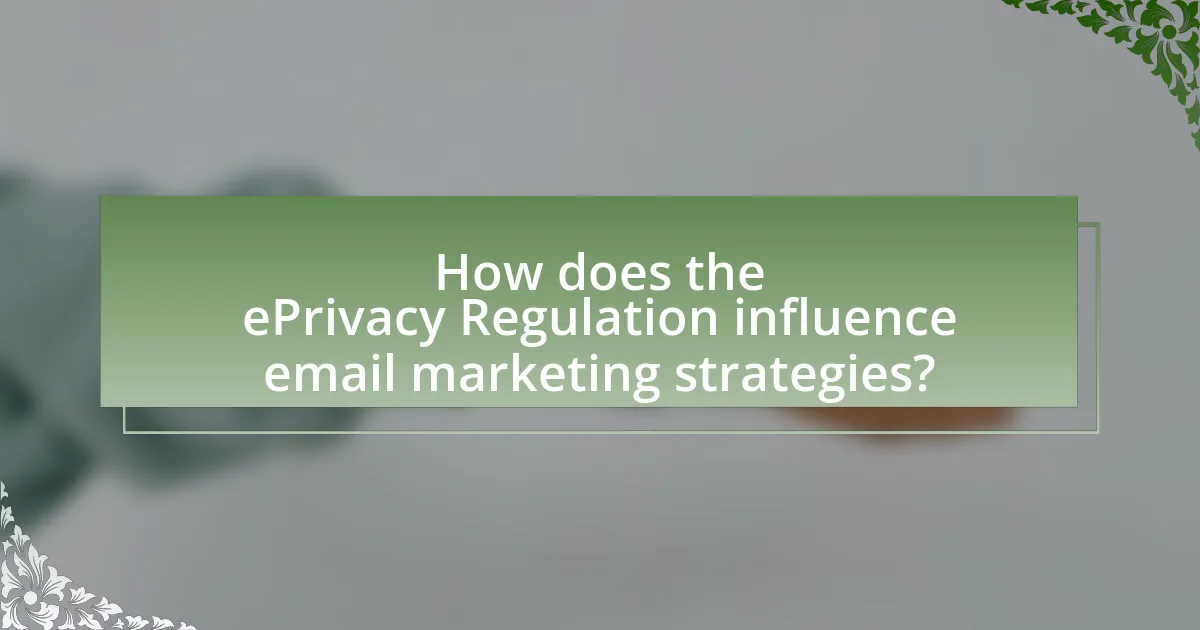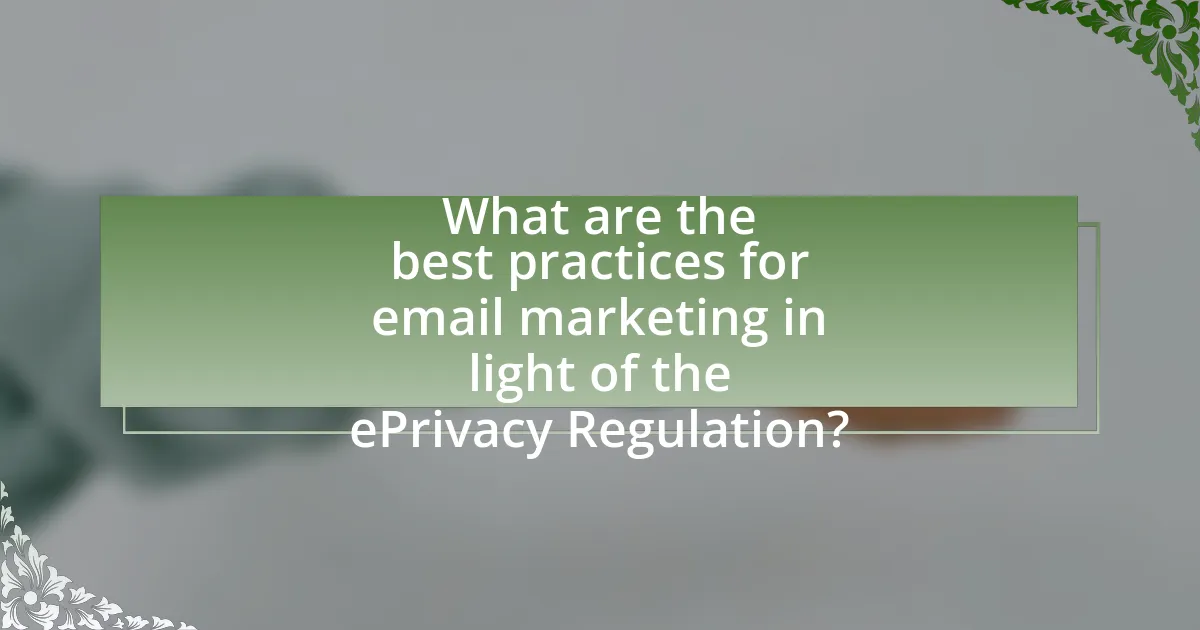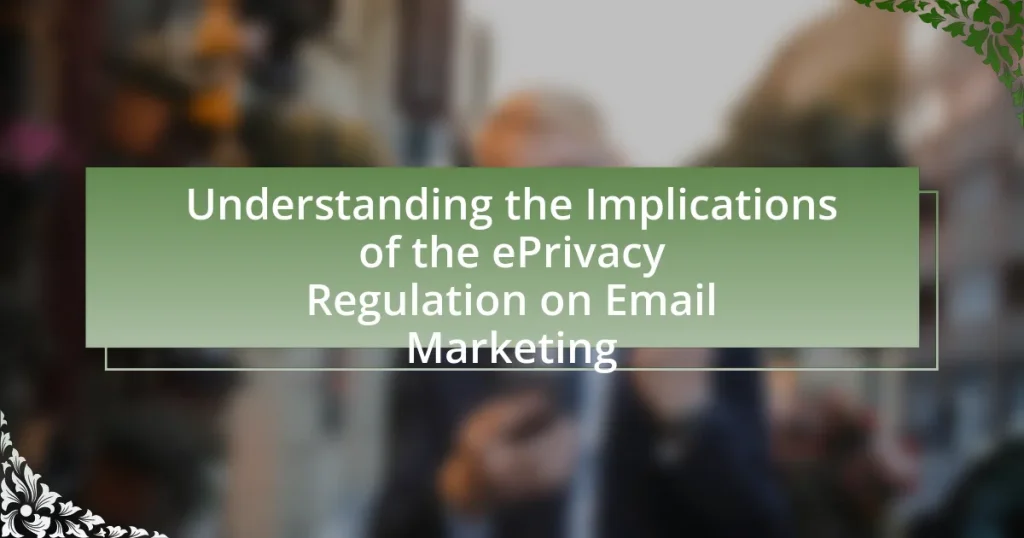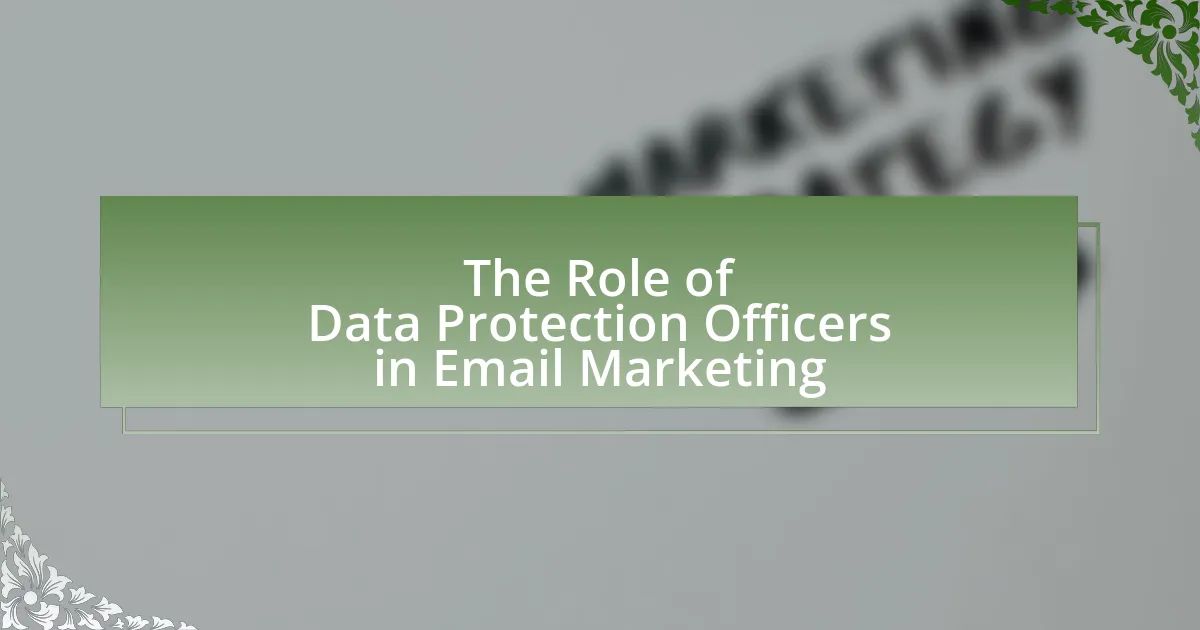The ePrivacy Regulation is a European Union legislative proposal designed to enhance privacy and data protection in electronic communications, particularly impacting email marketing practices. It establishes strict consent requirements, mandating that businesses obtain explicit consent from individuals before sending promotional emails, and emphasizes transparency regarding data usage. The regulation aligns with the General Data Protection Regulation (GDPR) and outlines key principles such as consent, transparency, and data protection, which collectively aim to safeguard user privacy. Businesses must adapt their email marketing strategies to comply with these regulations, ensuring that consent mechanisms are clear and that recipients are informed about how their data will be used. Non-compliance can result in significant penalties, making adherence to the ePrivacy Regulation essential for maintaining trust and effective marketing practices.

What is the ePrivacy Regulation and its relevance to email marketing?
The ePrivacy Regulation is a European Union legislative proposal aimed at enhancing privacy and data protection in electronic communications, including email marketing. This regulation is relevant to email marketing as it establishes strict consent requirements for sending marketing communications, mandating that businesses obtain explicit consent from individuals before sending promotional emails. Additionally, the ePrivacy Regulation emphasizes the importance of transparency, requiring marketers to clearly inform recipients about how their data will be used. This regulation aligns with the General Data Protection Regulation (GDPR) and aims to protect user privacy while ensuring that email marketing practices comply with legal standards.
How does the ePrivacy Regulation impact consent requirements for email marketing?
The ePrivacy Regulation mandates that explicit consent is required for email marketing communications. This regulation emphasizes that consent must be informed, specific, and freely given, meaning individuals must actively opt-in to receive marketing emails rather than being automatically subscribed. Furthermore, the regulation stipulates that organizations must provide clear information about the purpose of data collection and the use of personal data in marketing efforts. This aligns with the General Data Protection Regulation (GDPR), reinforcing the necessity for transparency and accountability in obtaining consent.
What constitutes valid consent under the ePrivacy Regulation?
Valid consent under the ePrivacy Regulation requires that individuals provide a clear, affirmative action indicating their agreement to the processing of their personal data. This means consent must be informed, specific, unambiguous, and given freely, without any coercion. The regulation emphasizes that pre-ticked boxes or inactivity do not constitute valid consent. Furthermore, individuals must be able to withdraw their consent easily at any time, reinforcing the need for transparency and control over personal data.
How can businesses ensure compliance with consent requirements?
Businesses can ensure compliance with consent requirements by implementing clear and transparent consent mechanisms that align with the ePrivacy Regulation. This involves obtaining explicit consent from individuals before processing their personal data for email marketing purposes, ensuring that consent is freely given, specific, informed, and unambiguous. Additionally, businesses should maintain detailed records of consent to demonstrate compliance and provide individuals with easy options to withdraw consent at any time. According to the European Data Protection Board, organizations must also regularly review and update their consent practices to adapt to any changes in regulations or business practices, ensuring ongoing compliance.
What are the key principles of the ePrivacy Regulation affecting email marketing?
The key principles of the ePrivacy Regulation affecting email marketing include consent, transparency, and data protection. Consent requires that marketers obtain explicit permission from individuals before sending marketing emails, ensuring that recipients have control over their personal data. Transparency mandates that marketers clearly inform recipients about how their data will be used, including the purpose of the email communications. Data protection emphasizes the secure handling of personal information, aligning with the General Data Protection Regulation (GDPR) to safeguard user privacy. These principles collectively aim to enhance user trust and compliance in digital marketing practices.
How does the regulation define personal data in the context of email marketing?
The regulation defines personal data in the context of email marketing as any information that relates to an identified or identifiable natural person. This includes data such as names, email addresses, and any other identifiers that can directly or indirectly identify an individual. The ePrivacy Regulation emphasizes the protection of such data to ensure that individuals have control over their personal information, particularly in marketing communications. This definition aligns with the General Data Protection Regulation (GDPR), which also categorizes personal data similarly, reinforcing the need for consent and transparency in email marketing practices.
What are the implications of data protection rights for email marketers?
Data protection rights significantly impact email marketers by imposing strict regulations on how they collect, store, and use personal data. Under regulations such as the General Data Protection Regulation (GDPR) and the ePrivacy Regulation, email marketers must obtain explicit consent from individuals before sending marketing communications. This requirement means that marketers must ensure their email lists are compliant, which can lead to reduced audience sizes if individuals opt out. Additionally, marketers are obligated to provide clear information about data usage and must allow recipients to easily withdraw consent at any time. Failure to comply with these regulations can result in substantial fines, with GDPR penalties reaching up to 4% of annual global turnover or €20 million, whichever is higher. Thus, data protection rights necessitate a more transparent and consent-driven approach to email marketing.

How does the ePrivacy Regulation influence email marketing strategies?
The ePrivacy Regulation significantly influences email marketing strategies by imposing stricter consent requirements for collecting and processing personal data. Marketers must obtain explicit consent from individuals before sending promotional emails, which necessitates a shift towards transparent and user-friendly opt-in mechanisms. This regulation also mandates that businesses provide clear information about how personal data will be used, compelling marketers to enhance their data privacy practices. As a result, companies may experience reduced email list sizes due to stricter consent protocols, but they can also benefit from higher engagement rates as they target individuals who have explicitly shown interest in their communications.
What changes should businesses make to their email marketing practices?
Businesses should enhance their email marketing practices by prioritizing consent-based strategies and ensuring compliance with the ePrivacy Regulation. This regulation mandates that businesses obtain explicit consent from users before sending marketing emails, which necessitates a shift from opt-out to opt-in models. According to a 2021 report by the European Commission, 70% of consumers prefer to receive marketing communications only after providing clear consent. Additionally, businesses should focus on personalizing content to improve engagement, as studies show that personalized emails can increase transaction rates by up to 6 times. Implementing these changes not only aligns with legal requirements but also fosters trust and improves customer relationships.
How can marketers adapt their strategies to comply with the ePrivacy Regulation?
Marketers can adapt their strategies to comply with the ePrivacy Regulation by ensuring explicit consent from users before collecting or processing their personal data. This involves implementing clear opt-in mechanisms for email subscriptions, where users actively agree to receive communications. Additionally, marketers should provide transparent information about data usage and allow users to easily withdraw consent at any time. According to the European Data Protection Board, compliance with the ePrivacy Regulation requires that consent be informed, specific, and unambiguous, reinforcing the necessity for marketers to prioritize user privacy and data protection in their email marketing practices.
What role does transparency play in email marketing under the regulation?
Transparency is crucial in email marketing under the ePrivacy Regulation as it ensures that consumers are fully informed about how their personal data will be used. The regulation mandates that marketers must clearly disclose their identity, the purpose of data collection, and how recipients can opt out of communications. This requirement is supported by Article 7 of the ePrivacy Regulation, which emphasizes the necessity of obtaining explicit consent from users before sending marketing emails. By adhering to these transparency guidelines, businesses not only comply with legal standards but also build trust with their audience, ultimately enhancing customer relationships and engagement.
What are the potential penalties for non-compliance with the ePrivacy Regulation?
The potential penalties for non-compliance with the ePrivacy Regulation can include fines of up to €20 million or 4% of the total worldwide annual turnover of the preceding financial year, whichever is higher. This regulation aims to protect the privacy of individuals in electronic communications, and enforcement is typically carried out by national data protection authorities. Non-compliance can also lead to reputational damage and loss of consumer trust, which can significantly impact business operations.
What fines can businesses face for violating the ePrivacy Regulation?
Businesses can face fines of up to €20 million or 4% of their global annual turnover, whichever is higher, for violating the ePrivacy Regulation. This regulation, which complements the General Data Protection Regulation (GDPR), imposes strict rules on electronic communications and privacy. The severity of the fines reflects the importance of compliance in protecting user privacy and ensuring transparent communication practices.
How can companies mitigate risks associated with non-compliance?
Companies can mitigate risks associated with non-compliance by implementing robust compliance programs that include regular audits, employee training, and clear policies. These programs ensure that all employees understand the legal requirements of the ePrivacy Regulation, which governs email marketing practices. For instance, a study by the International Association of Privacy Professionals found that organizations with comprehensive compliance training reduced their risk of non-compliance incidents by 30%. Additionally, utilizing technology solutions for data management and consent tracking can help companies maintain compliance with regulations, thereby minimizing potential fines and reputational damage.

What are the best practices for email marketing in light of the ePrivacy Regulation?
The best practices for email marketing in light of the ePrivacy Regulation include obtaining explicit consent from recipients, providing clear opt-in options, and ensuring transparency about data usage. Explicit consent is required under the ePrivacy Regulation, meaning marketers must obtain clear permission from individuals before sending marketing emails. This can be achieved through double opt-in methods, where users confirm their subscription via a follow-up email. Additionally, marketers should include easy opt-out options in every email, allowing recipients to withdraw consent effortlessly. Transparency about how personal data will be used is also crucial; marketers should clearly inform subscribers about data collection, processing, and sharing practices. These practices align with the ePrivacy Regulation’s emphasis on user privacy and data protection, ensuring compliance and fostering trust with consumers.
How can businesses effectively obtain and manage consent for email marketing?
Businesses can effectively obtain and manage consent for email marketing by implementing clear opt-in processes and maintaining transparent communication about data usage. This involves providing users with straightforward options to subscribe, ensuring that consent is informed and specific, as required by regulations like the ePrivacy Regulation. For instance, using double opt-in methods, where users confirm their subscription via email, enhances the validity of consent. Additionally, businesses should regularly review and update their consent records to comply with legal requirements and respect user preferences, which can be supported by utilizing consent management platforms that track and document consent status.
What tools and techniques can help streamline consent management?
Tools and techniques that can help streamline consent management include consent management platforms (CMPs), automated workflows, and user-friendly interfaces. CMPs, such as OneTrust and TrustArc, enable organizations to collect, manage, and document user consent efficiently, ensuring compliance with regulations like the ePrivacy Regulation. Automated workflows facilitate the process of obtaining and updating consent, reducing manual errors and improving efficiency. User-friendly interfaces enhance the user experience, making it easier for individuals to provide or withdraw consent, which is crucial for maintaining trust and compliance. These tools collectively support organizations in navigating the complexities of consent management effectively.
How can businesses educate their customers about consent and data usage?
Businesses can educate their customers about consent and data usage by implementing clear and transparent communication strategies. This includes providing easily accessible information about how customer data will be collected, used, and shared, as well as obtaining explicit consent through straightforward opt-in processes. Research indicates that 79% of consumers are concerned about how their data is used, highlighting the importance of transparency in building trust. Additionally, businesses can utilize educational resources such as webinars, FAQs, and informative emails to explain the implications of data usage and the rights customers have under regulations like the ePrivacy Regulation. This proactive approach not only informs customers but also fosters a sense of security regarding their personal information.
What strategies can enhance email marketing effectiveness while ensuring compliance?
To enhance email marketing effectiveness while ensuring compliance with the ePrivacy Regulation, marketers should implement strategies such as obtaining explicit consent, segmenting email lists, and personalizing content. Obtaining explicit consent ensures that recipients have willingly opted in to receive communications, which is a requirement under the regulation. Segmenting email lists allows marketers to target specific audiences with relevant content, increasing engagement rates; studies show that segmented campaigns can lead to a 760% increase in revenue. Personalizing content based on user behavior and preferences can further improve open and click-through rates, as personalized emails deliver six times higher transaction rates. These strategies not only align with compliance requirements but also drive better marketing outcomes.
How can segmentation and personalization be used within the regulatory framework?
Segmentation and personalization can be effectively utilized within the regulatory framework by ensuring that marketing practices comply with data protection laws, such as the ePrivacy Regulation. By segmenting audiences based on consented data, marketers can tailor communications to specific groups while respecting individual privacy preferences. For instance, the ePrivacy Regulation mandates that organizations must obtain explicit consent before processing personal data for marketing purposes, which means that segmentation strategies must be built on data collected with clear consent. This approach not only aligns with legal requirements but also enhances customer engagement, as personalized content is more relevant to the recipient. Furthermore, adhering to these regulations can mitigate the risk of penalties, as non-compliance can lead to significant fines, reinforcing the importance of integrating segmentation and personalization within a compliant framework.
What metrics should businesses track to measure compliance and effectiveness in email marketing?
Businesses should track metrics such as open rates, click-through rates, unsubscribe rates, and bounce rates to measure compliance and effectiveness in email marketing. Open rates indicate how many recipients engaged with the email, reflecting the effectiveness of subject lines and sender reputation. Click-through rates show the percentage of recipients who clicked on links within the email, demonstrating content relevance and engagement. Unsubscribe rates reveal how many recipients opted out, which can indicate compliance with consent regulations and content satisfaction. Bounce rates measure the percentage of emails that could not be delivered, highlighting issues with list quality and compliance with data accuracy requirements. Tracking these metrics allows businesses to assess their email marketing strategies in the context of the ePrivacy Regulation, ensuring they maintain compliance while optimizing effectiveness.
What are the common challenges businesses face with the ePrivacy Regulation in email marketing?
Businesses face several common challenges with the ePrivacy Regulation in email marketing, primarily related to consent management, compliance complexity, and data protection. The requirement for explicit consent from users before sending marketing emails complicates the process, as businesses must implement robust systems to track and manage consent effectively. Additionally, the regulation’s intricate legal language and varying interpretations across EU member states create compliance difficulties, leading to potential legal risks and penalties. Furthermore, businesses must ensure that their data handling practices align with stringent privacy standards, which can require significant operational adjustments and resources. These challenges highlight the need for businesses to invest in compliance strategies and technologies to navigate the regulatory landscape effectively.
How can businesses overcome obstacles related to consent and data management?
Businesses can overcome obstacles related to consent and data management by implementing transparent data practices and utilizing consent management platforms. Transparent data practices involve clearly communicating to users how their data will be used, which builds trust and encourages consent. Consent management platforms streamline the process of obtaining, managing, and documenting user consent, ensuring compliance with regulations like the ePrivacy Regulation. According to a study by the International Association of Privacy Professionals, organizations that prioritize transparency and user control over data see a 20% increase in user engagement and trust.
What resources are available to help businesses navigate the ePrivacy Regulation?
Businesses can access various resources to navigate the ePrivacy Regulation, including official guidelines from the European Data Protection Board (EDPB), which provide detailed interpretations of the regulation. Additionally, legal firms specializing in data protection law offer consultations and publications that clarify compliance requirements. Industry associations, such as the Direct Marketing Association (DMA), also provide toolkits and best practice guides tailored to email marketing under the ePrivacy Regulation. Furthermore, webinars and training sessions hosted by data protection experts can enhance understanding and implementation of the regulation. These resources collectively support businesses in ensuring compliance and adapting their email marketing strategies effectively.



